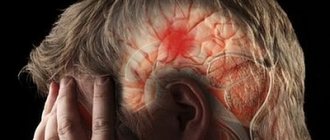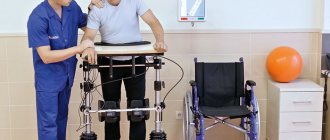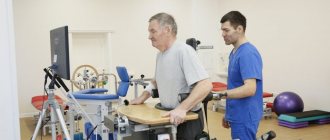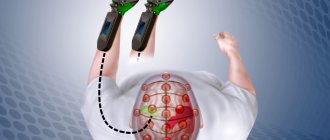Why does the hand stop moving after a stroke?
A stroke occurs due to an acute circulatory disorder in the brain, in which a portion of it dies. Depending on which part of the brain is affected, a person’s brain function is impaired. Because of this, various organs may stop functioning, including limbs - for example, a hand. Because the nerve pathways cross, the left arm will be affected if the stroke occurs in the right hemisphere, and vice versa.
At the same time, there is another dependence: the closer to the right hemisphere the stroke occurred, the more painful the damage to the limbs is felt. This happens because it is in the right hemisphere of the brain that the nerve centers responsible for the motor activity of the body are located. Therefore, a stroke, after which the left arm fails, usually requires longer rehabilitation.
Both types of stroke - ischemic and hemorrhagic - can cause such lesions and impair the motor activity of the hand. Disturbances can be different: pain, loss of sensitivity and coordination, complete paralysis of a limb.
Hand tremors
Thyrotoxicosis
Diabetes
Stroke
Encephalitis
27778 November 25
IMPORTANT!
The information in this section cannot be used for self-diagnosis and self-treatment.
In case of pain or other exacerbation of the disease, diagnostic tests should be prescribed only by the attending physician. To make a diagnosis and properly prescribe treatment, you should contact your doctor. Hand tremors: causes of occurrence, what diseases cause them, diagnosis and treatment methods.
Definition
Tremor is a medical term for trembling in various parts of the body caused by contraction of antagonist muscles. Hand tremor can be either a physiological reaction of the body to severe fear, fatigue, hypothermia, alcohol intoxication (physiological tremor), or a symptom of a number of serious diseases (pathological tremor).
Types of tremor
By localization:
- focal tremor - affects only one anatomical area, for example, arms, head, jaw;
- segmental tremor - involves two or more adjacent parts of the body, for example, tremor of the arms and head;
- hemitremor – trembling spreads to several areas of the body on one side;
- generalized tremor - trembling is widespread and affects simultaneously the arms, legs, head, tongue and voice.
In relation to movement:
- rest tremor;
- action tremor.
According to the vibration frequency,
hand tremors are divided into 3 groups:
- low frequency (less than 4 Hz);
- mid-frequency (4–8 Hz);
- high frequency (8–12 Hz).
The amplitude of
the vibration is divided into:
- to low amplitude,
- medium amplitude,
- high amplitude.
According to severity:
- slight tremor;
- moderate tremor;
- significant tremor;
- pronounced tremor.
Depending on the cause:
- hereditary;
- acquired.
Based on the presence of accompanying symptoms:
- isolated - tremor is the only symptom;
- combined – other neurological symptoms are present.
Possible causes of hand tremor
Physiological tremor is called tremors in the hands against the background of emotional overexcitation, fatigue, fever, after heavy physical exertion, when taking certain medications, coffee, alcohol, or smoking. This type of tremor usually goes away on its own once the underlying cause is eliminated.
Pathological tremor can be a symptom of a fairly large number of diseases.
Endocrine disorders When
the level of thyroid hormones is elevated,
a person often experiences trembling in his hands. In addition, there may be weight loss with increased appetite, muscle weakness, a feeling of heat at room temperature, the skin becomes warm and moist, the heart rate increases, the patient becomes quick-tempered, overly emotional, and the volume of the thyroid gland gradually increases.
In patients with diabetes mellitus
with a sharp decrease in blood glucose levels, not only trembling of the hands, but also clouding of consciousness, even fainting, may be observed. Patients with diabetes need to control their sugar levels and not skip meals.
Metabolic disorders In a rare hereditary disease - Wilson-Konovalov disease
– hand tremors can appear at a young age. The cause of the disease is a violation of copper metabolism in the body; it begins to be deposited in the tissues of organs, disrupting their functioning.
Pathologies of the cardiovascular system
Patients with hypertension
may experience tremors in their hands when their blood pressure rises sharply.
Neurological pathologies Parkinson's disease
– a slowly progressive neurological disease, most common in older people. The exact cause of this disease is still not clear. In Parkinson's disease, hand tremors are one of the first symptoms, appearing at rest, and are eventually joined by head tremors. The tremor increases with excitement and physical activity; in addition, there is an imbalance, muscle weakness, gradual decline of cognitive abilities, memory loss, and depression.
Currently, Parkinson's disease is incurable, but existing treatment methods, especially with timely diagnosis, significantly improve the course of the disease.
Lesions of the cerebellum
as a result of cancer, trauma, encephalitis or stroke are characterized by the so-called large-scale tremor. In addition to trembling, gait and coordination of movements are impaired.
Essential tremor is distinguished separately
. This is a hereditary disease of the nervous system, in which there is a moderate intensity trembling of the hands that occurs during movement and gradually progresses. The disease often begins in middle age, does not affect other body functions, and does not affect mental abilities or memory. In old age, tremor increases, which can lead to a significant decrease in quality of life.
Essential tremor is often mistaken for Parkinson's disease, a much more serious disease that leads to severe disability.
Diseases of the musculoskeletal system In some cases, osteochondrosis of the cervical spine
may cause trembling and numbness in the hands.
Autoimmune diseases
Tremor in
multiple sclerosis
is one of the most common symptoms, and tremors appear not only in the hands, but also in other parts of the body.
Another possible cause of hand tremors is poisoning with toxic substances.
, for example, carbon monoxide, salts of heavy metals.
This is a life-threatening condition that requires immediate medical attention. Trembling hands can become a side effect when taking certain medications (neuroleptics, antidepressants, psychostimulants, some antiarrhythmic drugs, medications for bronchial asthma, etc.).
Which doctors should I contact for hand tremors?
Hand tremors may occur in emergency situations. Increased blood pressure, a sharp decrease in glucose levels in patients with diabetes, injury, stroke - these conditions require immediate medical attention.
In other cases, the first specialist to whom patients turn when tremors appear in their hands becomes. If necessary, consultation may be required; , psychotherapist.
Diagnosis and examinations for hand tremors
Primary diagnosis consists of examining the patient and carefully collecting anamnesis, the doctor specifies the time of onset of the problem and accompanying symptoms, asks the patient to perform several tests: for example, pour water from a cup, write something with your eyes closed (Gibson and Khersonsky maze test), etc. d.
To identify the cause of tremor, or more precisely, the disease that caused hand tremors, laboratory and instrumental diagnostics are prescribed.
Laboratory tests
- To exclude endocrine pathologies, a blood test is performed for thyroid hormones (free thyroxine (T4), free triiodothyronine (T3)), thyroid-stimulating hormone (TSH), antibodies to thyroid peroxidase, antibodies to thyroglobulin, and the level of insulin and cortisol is examined.
A set of measures to restore the hand after a stroke
Restoration of hand motor skills after a stroke occurs under the supervision of physiotherapists. The list of measures includes procedures in different areas:
- physical rehabilitation therapy;
- drug treatment;
- psychological counseling.
Physical rehabilitation therapy
Physical rehabilitation is a critical part of restoring arm movement after a stroke. It involves doctors of various specializations, but primarily physiotherapists, neurologists and rehabilitation specialists. Treatment is aimed at developing and strengthening everyday motor abilities.
The process uses:
- physical therapy and gymnastics
: physical exercises on the arm - from the simplest gradually to more complex, developing fine motor skills; - action and observation therapy
- during these procedures, the patient watches another person performing some actions with his hand (in person or on video), and then repeats after him. The method triggers the work of similar areas of the brain, and this helps restore motor skills of the hand; - mirror therapy method
- within the framework of this rehabilitation technique, a mirror is placed between the patient’s hands in such a way that the image of the movement of the healthy limb creates the illusion of the same normal movement of the affected arm; - tekar therapy
- radio wave exposure to the body to produce endogenous heat. This helps reduce pain and speed up the tissue healing process; - massage techniques
; - acupuncture, modeling
from dough, plasticine or clay; - hydrotherapy methods
: hydromassage baths, contrast and circular showers.
The rehabilitation department has an occupational therapy department and a neuromotor department for the upper limbs. Robotic technologies are used here, including virtual reality. Neuromotor rehabilitation using such high-tech systems is a modern method of restoring hand motor abilities.
The greatest effect is achieved when the doctor competently combines all these methods. In this case, the specialist must first assess the extent to which the patient’s condition allows him to undergo these measures.
Drug treatment
In most cases, rehabilitation of the hand after a stroke requires drug treatment. However, it must be strictly under the supervision of the attending physician.
There are no universal dosages and regimens; each patient needs his own therapy. To make a decision about which drugs and in what doses the patient needs, the specialist studies all available information about him. In particular, medical history, anamnesis, data on clinical manifestations, results of previous examinations and tests.
The doctor may also change your medication regimen during treatment if he has reason to believe that the current dosage is ineffective or insufficient. The basis is new biometric data, information from the patient’s daily records (“diary of a stroke patient”). First of all, we are talking about the dynamics of blood pressure, heart rate, as well as side effects from medications.
Types of drug therapy that are used to restore limb activity after a stroke:
- intramuscular and intravenous injections
, which are aimed at increasing vascular activity and strengthening neurons. These include Botox injections, which significantly reduce muscle spasticity; - lymphotropic drugs
, which are injected directly into the lymphatic system so that the active substance gets into the arm faster; - analgesics
(to reduce pain in the arm),
muscle relaxants
(to relax the muscles of the limb),
anticoagulants
(to prevent the formation of blood clots),
antidepressants
(to treat depression that has developed due to illness) and other drugs, including antibiotics, vitamins and potent drugs - of necessity.
Psychological counseling
The patient’s internal state greatly influences the process and result of restoring the activity of the arms and legs.
Rehabilitation in a specialized center forces a person to change his usual way of life: he distances himself from society, loses independence and independence even in everyday worries. This cannot but affect the psychological state and leads, at a minimum, to discomfort, and at most to the development of depression.
The patient needs understanding, respect and care, but may also experience anger and powerlessness due to loss of control over his own body. To deal with this, a psychotherapist is needed. He will develop the correct technique for working with the emotional state and select a communication method for the family. The doctor will also prescribe pharmaceutical treatment to the patient if it is necessary and fits into the overall drug treatment plan.
Causes
As a rule, physiological tremor is a reaction to overexertion and fatigue. Often such trembling occurs due to stress, depression, and emotional turmoil. As a rule, it is enough to rest, switch to a source of positive emotions, calm down, and the attack passes.
Pathological tremor appears as a concomitant symptom. Parkinson's disease is the most common cause. The limbs shake even in sleep, sometimes along with the head and shoulders.
In addition to parkinsonism, hand tremors can be caused by multiple sclerosis, thyrotoxicosis, cerebellar damage, alcohol poisoning, and dementia. Trembling begins in diabetic patients when blood sugar levels drop and stops after eating sweets.
What to do if your hands are shaking
First of all, it is necessary to establish the cause of the symptom. As a rule, physiological tremor goes away after a certain time after rest or a change in environment. If your hands continue to shake, although several days have passed after physical overload, you need to undergo an examination.
The minimum program is a visit to a therapist. Usually, after an initial examination, the doctor recommends contacting a neurologist, endocrinologist, taking tests to check the thyroid gland, and prescribing an MRI of the brain. The symptom goes away after some time after diagnosis and proper therapy, if the patient does not forget to take medications.
How to teach sitting, standing, walking
Already in the first days after a stroke, if the general condition is satisfactory, it is recommended to teach the patient to sit and stand. It is necessary to prepare in advance a scarf for fixing the arm, a rubber traction for the leg, and also choose comfortable shoes with low wide heels that fix the ankle joint (for example, weightlifting shoes, light men's shoes).
They begin to put the patient in bed as soon as his well-being and the state of the cardiovascular system allow. These periods can range from 3-5 days to 2-3 weeks from the onset of the disease and are determined by the attending physician.
Initially, the patient is in a reclining position for 3-5 minutes. For this purpose, a pillow is placed under his head and back. Gradually, in this way, over 2-3 days, the patient is transferred to a semi-vertical position, but sitting with legs down is allowed only approximately on the 4-5th day of classes. In this case, a pillow is placed under the patient’s back, the paretic arm is fixed with a scarf, and a bench is placed under the legs. The time of sitting in bed with legs down should be gradually increased from 10-15 minutes to 1-2 hours or more, depending on the patient’s well-being.
As soon as the patient begins to sit in bed with his legs down, exercises to strengthen the leg muscles are included in the complex of therapeutic gymnastics: using a rocking roller, an elbow expander or a rubber “frog” to fill air mattresses with air, adapted for training the lower leg muscles and developing movements in the ankle joint
At the same time, they begin to use exercises for the sore hand with various objects (for which some children's toys can be used). It is recommended to assemble and disassemble pyramids, children's construction sets, and various figures from cubes.
An important stage is learning to stand and walk. The patient is brought to him gradually. First, preparatory exercises are performed - passive and active imitation of walking in a lying position.
A passive imitation of walking consists in the fact that the practitioner, clasping the ankles of both legs of the patient with his hands, alternately bends and extends them at the knees, without lifting the feet from the sheet. Active imitation of walking is performed by the patient himself, if he retains the mobility of his paretic leg. If it is not there, then the practitioner helps the patient “walk.” The latter straightens and bends the healthy leg independently.
In agreement with the attending physician, the patient is then taught to stand. The first time he is asked to stand up, holding the bedside frame or headboard with his good hand. The practitioner must help the patient from the side of the paretic limbs. The patient should be supported by the waist, while simultaneously fixing the knee joint of the paretic leg in an extended state.
The patient should stand straight, evenly distributing body weight on the sick and healthy sides. At the very beginning of training, the patient can remain in a standing position for no more than a minute. Gradually, the time of standing on your feet is increased to 5-7 minutes. After the patient can confidently, holding the headboard of the bed, stand independently on both legs, they move on to teaching him how to alternately transfer the weight of the body to the healthy and sore leg.
To do this, the patient is asked to place his feet shoulder-width apart and slightly sway from side to side. In this case, you can use a rubber “frog”, on which the patient presses with the paretic leg: if the load on the sore leg is large enough, a characteristic sound of air escaping will appear. The patient must be supported while performing this exercise.
When the patient has mastered this exercise, it is necessary to teach him to stand on one leg, first on the healthy one. In this case, the paretic leg is in a bent position (with the help of the practitioner). When learning to stand on a sore leg, the student must first fix the knee joint of the paretic leg in an extended state at a right angle. It is better if another person is present to support the patient.
When performing this exercise, it is necessary that the patient has reliable support: a high headboard, a bedside frame, a bracket driven into the wall. There should be a chair behind him for safety or rest.
Teaching a patient to stand is an important and responsible stage in treatment. Do not rush to move on to the next exercises until the patient learns to feel confident on his feet independently, without your help. If you rush, the next stage may be unnecessarily delayed.
Learning to move should begin with the “walking in place” exercise. Then the patient must learn to walk forward, backward, sideways along the bed or table. He must do all this while holding onto the bedside frame or table. In the future, they begin to teach the patient to move without the help of these supports, but with support.
During recovery, at first the patient uses a three- or four-legged crutch when moving, then a stick. When learning to walk, you should pay attention to the position of the foot, check the patient’s stability, make sure that he bends his leg sufficiently at the hip and knee joint, does not lift it to the side, does not touch the floor with his toe, and places his foot correctly.
During training, it is better to fix the sore arm with a scarf to prevent stretching of the shoulder joint bursa, and to eliminate foot sagging, use devices that fix it: a rubber rod (connecting a sock or shoe with a garter located above the knee) or boots with a high rigid fastening.
To consolidate the skill of correct foot placement, it is advisable to walk along a path on which traces of training steps are marked. Another method is used for the same purpose - overcoming obstacles 5-15 cm high (for example, planks that are placed in front of footprints on the same path). You should constantly adjust the position of the foot when resting the entire sole on the floor, as well as when moving the leg.
When the patient begins to move independently around the room, the goal of physical therapy will be to strengthen the leg muscles necessary to restore correct gait.
At the next stage, the patient is taught to walk up the stairs, and one must be especially careful to protect the patient from falling. Since the patient expends significant effort during these exercises, it is necessary to pause from time to time to rest in a sitting position and to perform breathing exercises.
Simultaneously with exercises to restore leg function, exercises for the arm are performed. These are the already mentioned exercises with small objects - cubes, pyramids, plasticine, the use of a rocking table, a spring microexpander in the patient's position sitting at the table, and without objects. Here is one of them: the patient is seated with the affected side of the body on the table, and his outstretched paretic arm is placed on the table. The practitioner takes the patient’s hand, fixing his shoulder near the elbow. Then, shaking lightly, slowly bends the arm at the elbow and straightens it.
Another exercise is recommended. Starting position: sit facing the table, place your feet shoulder-width apart, place the sore arm bent at the elbow at a right angle, palm down (forearm along the table) with fingers straight and spread apart. The practitioner presses the patient’s hand to the table with one hand, and with the other raises the patient’s elbow up, shaking it lightly.
The following exercise helps reduce tone in the flexors of the forearm, hand and fingers. The patient is seated on a chair so that the hand of the affected hand is placed under the sore thigh. The practitioner, holding the shoulder with one hand, clasps the patient’s elbow with the other and straightens his arm at the elbow, shaking it lightly.
Various hanging movements and swinging of the limbs are also used to relax muscles. For example, the patient is seated with the affected side of the body against the back of a chair and the hand of a healthy hand is placed in the axillary area. As a result, the sore arm ends up suspended and is slowly swung, gradually increasing the amplitude. The same exercise can be performed on the couch: the patient lies on his back, with his sore arm hanging down.
To reduce muscle tone in the muscles of the hand, it is recommended to rub its back surface in the direction from the fingertips to the wrist.
The following exercise is also useful. The practitioner clasps the patient’s thumb with one hand, and with the other all the others (four fingers folded together) and performs their maximum extension, while simultaneously abducting and extending the patient’s thumb. The hand should be held in this position for 1-3 minutes until muscle relaxation is observed.
Sometimes the patient experiences involuntary concomitant movements, that is, when the leg is bent at the knee, the arm at the hand and elbow simultaneously bends. The same can be observed when coughing and sneezing. A number of exercises help eliminate friendly movements.
The following can also be recommended. Sit facing the table with your feet shoulder-width apart. Place your hands on the table and press the healthy sore hand. Slowly bend and straighten your leg at the knee (if this is difficult to do, then you should help the sore leg with the help of the healthy one), while simultaneously holding your arm in an extended position. You can also sit on a chair and stretch your arms forward (paretic below, healthy above), put them on a cane, which is located on the side of the sore leg.
It is necessary to keep your arms extended the next time you move your legs. Place the sore leg on the knee of the healthy one, return to the starting position, place the healthy leg on the knee of the sore one, return to the starting position. In addition to exercises for paretic limbs, the complex of therapeutic exercises must include exercises for healthy limbs. Actually, every therapeutic gymnastics procedure from the first days of classes should begin with exercises for healthy limbs.
It should also be borne in mind that throughout the entire recovery period, in addition to active gymnastics (light resistance training, relaxation exercises, and breaking concomitant movements), passive movements continue to be used for the joints of paretic limbs.
Patients will be able to perform some of them independently. For example, for the shoulder joint - lock your arms, raise them up (the healthy arm works, the sick one is passive), then tilt them left and right. Take the gymnastic stick with both hands, lift it up (the healthy arm works, the sick one is passive), lower the stick behind the head. Passive movements for the wrist joint can also be carried out by the patient himself, helping himself with his healthy hand - doing extension, flexion, circular rotation in one direction and the other. Passive movements for a paretic foot can be performed with a healthy hand, placing the bent sore leg on the knee of the healthy one.
When performing both active and passive movements, it is necessary to achieve the greatest possible range of movements. These exercises should be performed rhythmically, at a calm pace. As noted above, all active movements should be alternated with relaxation exercises.
Causes
The occurrence of seizures after a stroke is associated with the death of neurons. The body, in order to limit the necrotic lesion and preserve the connection between nerve cells, redistributes the functions of the affected cells between healthy neurons.
The protection mechanism is implemented through the formation of a cavity that is filled with liquid. This neoplasm does not have a significant impact on the patient’s well-being and quality of life. However, in some cases it can irritate neurons, resulting in seizures.
Neurologists call the main causes of seizures that develop after a stroke, adhesions, cysts and various neoplasms. However, experts also identify factors that can provoke and aggravate convulsive syndrome:
- side effects that occur when taking certain medications;
- suffered stress or a state of emotional distress;
- psychological and physical fatigue.
Convulsive syndrome is a dangerous consequence of a stroke, in which a shock reaction occurs in the body. Neurologists at the Yusupov Hospital use effective developments in modern medicine to eliminate the causes of seizures after a stroke.
Consequences
Seizures after a stroke require immediate treatment, as they can cause the development of certain pathologies. The greatest danger for the patient is convulsions accompanied by loss of consciousness during the period of exacerbation of the disorder. The main consequences of convulsive syndrome are:
- repeated cerebrovascular accidents;
- short-term or long-term loss of consciousness. Some patients fall into a coma after seizures, since seizures are a serious stress for their body;
- disability as a consequence of seizures occurs with constant seizures, which, due to the severity of brain damage, are difficult to treat. In this condition, restoration of functions is also difficult;
- death is possible in the absence of treatment for seizures, frequent and intense seizures. Most often, seizures are of this nature when the brain stem is damaged, damage to which can cause the activity of the respiratory and cardiac systems to stop.
Neurologists at the Yusupov Hospital note psychosomatic problems in patients with this disorder, so professional psychologists, neurodefectologists and psychotherapists are involved in the process of their treatment and rehabilitation. People who have suffered a stroke are often unable to care for themselves and lose the ability to move and perform everyday tasks. Convulsive syndrome aggravates their condition, as a result of which people experience a feeling of inferiority.









